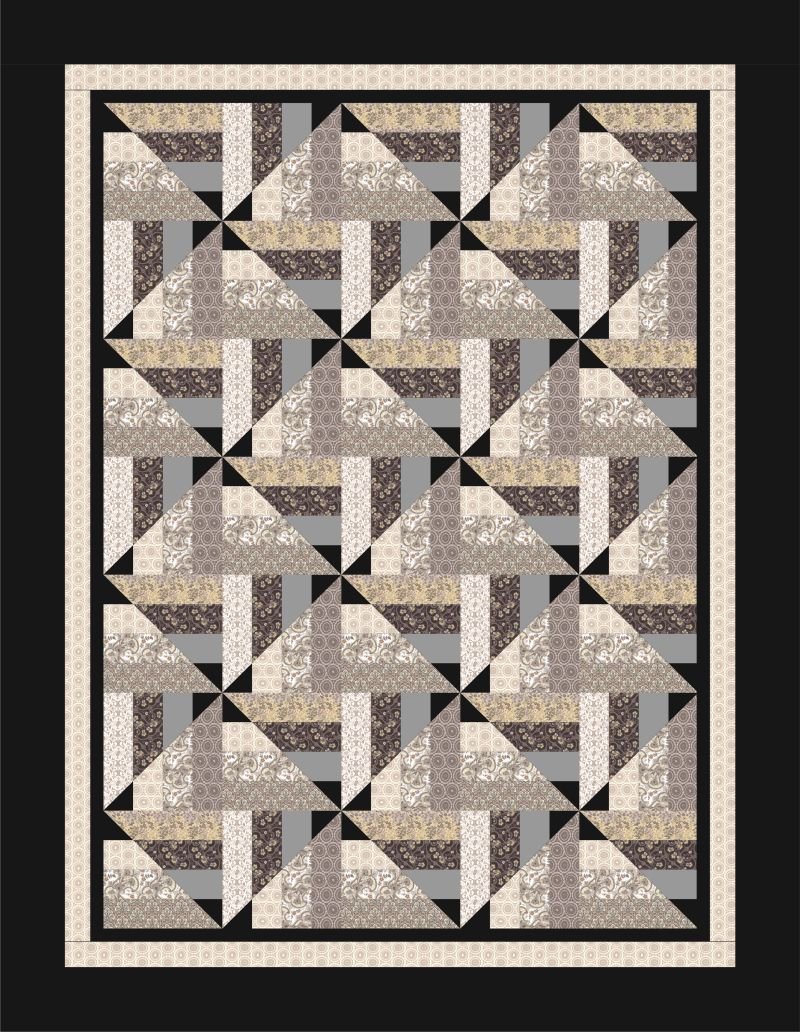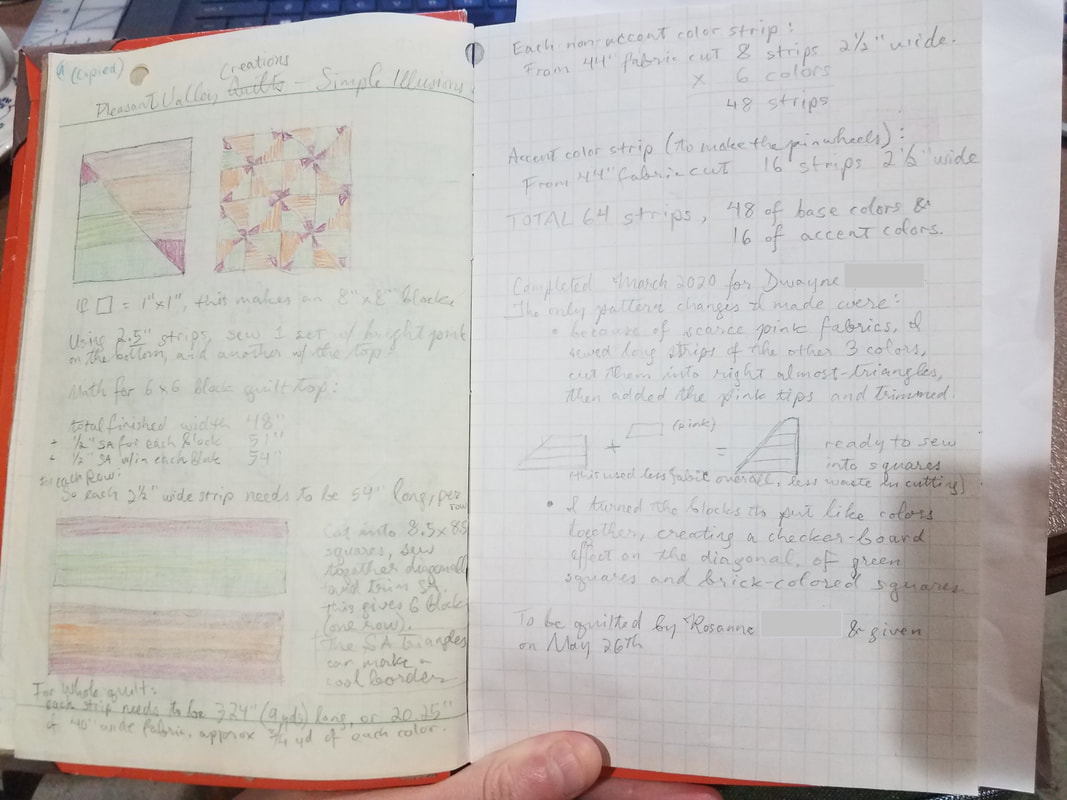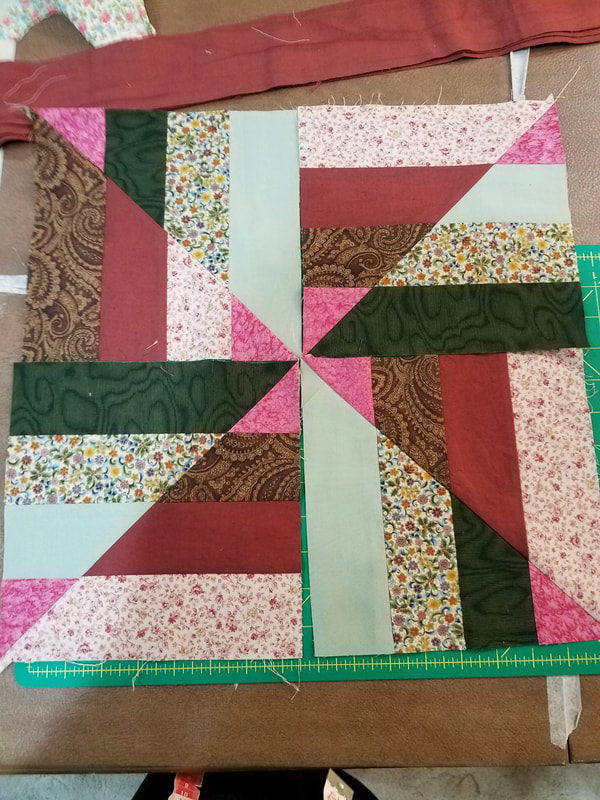PATTERN
Because of a paucity of the pink batik I wanted to use for the pinwheels, I sewed bands of three colors, cut them into right triangles that were missing their tips, and then used pink scraps for the tips. Cutting the almost-triangles this way meant I could save some fabric by turning the triangle ruler upside down every other cut, which means the order of the strips mirrors from block to block. The pink was never part of the bands, so I never lost any by having to reject triangles where the pink strip was on the long side. Because of all this making-do, I probably put the block together differently from the Pleasant Valley Creations pattern, but I got the pinwheel effect all the same. As I worked, I began to see the greens as forest paths, and the reds as bricks and earth, and I thought of the many hikes my friend Dwayne and I have gone on. Soon, I knew the quilt would be for him. My friend Rosanne got excited then, and offered to do the quilting, making this a joint gift from us to Dwayne. Yay! Still working on the design wall, I rotated my blocks to group greens together and reds together, creating a checkerboard effect diagonally across the work. That was my favorite layout, so I sewed it together, and put two borders on to frame it. SANDWICHING & QUILTING The quilt sandwich consisted of the quilt top, some Warm and Natural punched cotton batting (low loft), and a 100% Egyptian Cotton sateen sheet I found at the thrift store. I put the sateen side out, because I liked its sheen. Rosanne and I spent a good afternoon sandwiching and safety-pinning two quilt tops, one for her and one for me. Then she spent two nights machine quilting Dwayne's quilt using decorative stitches in long crosshatching across the whole quilt. (I love the picture of Rosanne quilting, because on the design wall behind her you can see some of her work: far more traditional blocks done with precision and in Civil War era colors. So different from mine, but so beautiful!) FINISHING Finally, it was time to finish! I originally thought I'd do a wrap-around facing, using the backing material, but changed my mind when I realized I needed to square the edges. So I trimmed and squared the edges, and did a double-fold binding using instructions from the book Fantastic Finishes, printed by Rodale's Successful Quilting Library, and joining the ends using this tutorial. The finished dimensions are 53" square, making this a throw quilt, suitable for tossing on a couch or in a car to keep the lap warm. I did a pretty okay job on most of the binding, but need to practice my mitered corners more. I love the look of Rosanne's decorative stitches on the back, against the sateen! I love that she quilted diagonally, in line with the illusory checkerboard and not the blocks. I love the warm colors of the piecing (these pictures don't do it justice). I hope Dwayne loves it too! INTELLECTUAL PROPERTY, AND RESPECT BETWEEN MAKERS Intellectual property law is intended to protect the rights of creators and inventors to benefit from their work. The laws relating to it can be bafflingly complex... for instance, let's say you buy a printed cotton with Disney princesses on it. Disney has licensed the use of those images to the fabric maker, so Disney is being compensated for the princesses. If you make a quilt for your child using that fabric, fine. But if you put that same quilt up for sale on Etsy, watch out! You don't have the right to make money off of Disney's princesses, even if you did buy the fabric from someone who paid for the images. Now, what if you used non-Disney images in very Disney-inspired ways, to make a "princess" blanket that anyone would see and think "Disney", but none of it was actually Disney stuff? Now you're in the clear as long as you don't call it "Disney". What if you copy or reproduce Disney pictures for your own fan-art, but don't sell it or make money off it in any way? A slightly gray area. Fan-art (like fan-fiction) and other derivative works can be protected as long as they do not infringe on Disney's right to make money off their own stuff, do not purport to be canonical, and do not degrade the original franchise (some very ill-defined and debatable caveats). My understanding of this is sketchy at best, since it's been years since I dipped my toes in fandom; the laws and application of laws are ever evolving. Clothing, which is where most of my sewing experience is, is not copyrightable. Because it's considered necessary and utilitarian, and because there's not much variation in the basic forms, someone trying to copyright, say, a coat, would be unfairly limiting other people's right to dress themselves! Fashion designers might put a lot of thought and creativity into designing a collection, only to have the whole thing copied and knockoffs sold almost immediately. So designers protect their income through trademarks (like their tags, logos, and names) that identify clothing, and that can be protected legally. Meanwhile, commercially made sewing patterns are copyrighted in the form that they're sold: i.e. the paper pattern or digital download is copyrighted and cannot be reproduced without permission. When you buy the pattern, you have bought a license to use it to make things for yourself or others (not for profit), or to make things for others for money, as long as what you're selling is your labor, and not the pattern itself. I knew a woman who made custom bridal stuff, who when asked to make the gowns for six bridesmaids had each one buy the pattern herself, so she could sell her labor to make the dresses, but not infringe on the pattern maker's right to get paid for the pattern. If she had bought the pattern once, and sold the labor to make the gowns six times, she might've been breaking the law. So each bridesmaid, in essence, bought a pattern and paid her to make it. Quilting, like clothing, is a complicated area of intellectual property. Quilts are utilitarian objects, and many quilt blocks are so old and traditional as to be within the public domain. Trying to copyright a four-patch, for instance, would be ludicrous. Nevertheless, designers and artists are still making new patterns, or using old blocks in innovative ways, or using traditional blocks in traditional ways, but doing all the math and writing the instructions for other makers to follow a pattern. Even if the medium is utilitarian and public, the intellectual labor is still labor and deserves to be compensated, and the original designs should be respected. For my Dandelion quilt pattern, which I am working up from my own imagination, I am spending time, money, and energy to make it. Once I put it out in the world, I want to get some compensation for my labor. I would be okay with someone copying the idea if they did all the hard work themselves, but I'd be piqued if someone simply copied my instructions without paying me for them, and I'd be more than piqued indeed if someone copied my instructions and started selling them and making money off my work. While there's lots of room for quibbling, and courts are generally reluctant to wade into the realm of art or the question of women getting paid for "women's work", the usual trend when the copyrightability of quilts goes to trial is summed up in this 2010 article: There are many block patterns that are a storied part of our textile history and should be freely available for all to use as the basis for their own creations. That being said, the artistic choices of color, layout,and quilting are entitled to the same protection as the choices made in the composition and creation of a painting. For that is what many of these quilts are-paintings made of fabric and thread rather than canvas and oils. While no one quilter can capture the idea of the "Sunbonnet Sue" or the "Courthouse Steps" patterns, any quilter who puts her own spin on these traditional designs, or any quilter who creates a representational landscape or an abstract design, is entitled to protection for those aspects of the design that go beyond the original idea. So what about what I've done with this Pleasant Valley Creations pattern? Here are the facts as I understand them:
I contacted her to lay the situation before her, and offered to buy her pattern, anyway, so she'd be compensated for her design work even if I didn't use her pattern to make my quilt. Generously, she replied saying I need not buy the pattern, and giving me permission to blog about this as long as I gave her credit for the design and linked her site so others could buy her pattern if they wanted. So... Credit where credit is due! Diana Beaubien of Pleasant Valley Creations inspired this quilt with her "Simple Illusions" design. If you'd like to make a similar quilt, check out her pattern #455, which you can get in paper or download as pdf. Unlike my kluge-job, her pattern includes yardage information and instructions for making it as a Crib size (48" x 64"), a Throw (56" x 72"), a Twin (72" x 96"), a Queen (80" x 96"), and a King (96" x 112"). While you're there, check out her other patterns; you may find your next project!
5 Comments
The Sister
5/17/2021 11:18:28 am
How very interesting! I think your reference to Disney was likely due to our conversation about my watercolor princess, and I had been equally fascinated by the research I myself did into the topic of copyright and IP laws! I'm glad you did the work and learned what's allowed and how to respect the original artist - that's not always appreciated in today's culture.
Reply
I'm also trying to figure this out on my own, because I am simple not able to afford $10 on a pattern right now, due to lack of employment and the current state of the economy. Sad, but true. I made one strip-set using 4 2.5 inch strips of alternating colors, but I only got 2 units that are usable. I realize now that I need to make another strip-set with the pinwheel color being on top, but what ruler or tool should I actually use to cut them? Thanks in advance.
Reply
Hi Kelly!
Reply
10/15/2023 02:26:29 pm
A question - In the Simple Illusions pattern, my blocks end up 8x8 after trimming. Is this correct? Thanks for any help. Warmly, Carol
Reply
In any quilt block, you have the "unfinished size" (from raw edge to raw edge, or what you trim the block to) and the finished size (from seam to seam, or what you see of the block when it's sewn to other blocks). When a pattern says "trim to ____ size", or "_____ size unfinished", that's the first one.
Reply
Leave a Reply. |
Karen Roy
Quilting, dressmaking, and history plied with the needle... Sites I EnjoyThe Quilt Index Categories
All
Archives
March 2024
|












 RSS Feed
RSS Feed